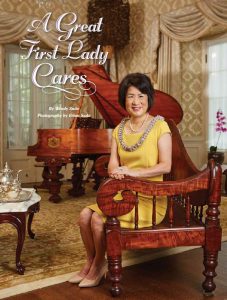 Hawai‘i’s first lady, Dawn Amano-Ige, is a wife (married to Gov. David Ige), a mother of three, a sister and a daughter. Dawn’s mother, Mitsue Amano, provided childcare for the Ige kids when Dawn was a young, working mother and David was a new legislator. Today, at 94 years old, Mitsue is no longer the family’s caregiver. That’s now Dawn’s role.
Hawai‘i’s first lady, Dawn Amano-Ige, is a wife (married to Gov. David Ige), a mother of three, a sister and a daughter. Dawn’s mother, Mitsue Amano, provided childcare for the Ige kids when Dawn was a young, working mother and David was a new legislator. Today, at 94 years old, Mitsue is no longer the family’s caregiver. That’s now Dawn’s role.
Mitsue has Alzheimer’s disease.
When Dawn first learned of her mother’s diagnosis, she had very little idea of exactly what she and her family would face as caregivers. She recalls being given a fact sheet from the Alzheimer’s Association and learning that she was one of 65,000 in Hawai‘i caring for more than 29,000 people living with Alzheimer’s disease and other dementia.
Nearly 5 percent of Hawai‘i’s residents care for someone living with Alzheimer’s disease. And since the start of the COVID-19 pandemic, that number has increased. In March 2020, all adult day care services closed, and many residential facilities sent patients home to their families to allow for increased social distancing and reduced staffing. People who weren’t already full-time caregivers suddenly found themselves in exactly that position.
“My mother has no short-term memory and she knows that,” says Dawn. “I always greet her by saying, ‘Hi Mom — do you know who I am?’ as I hope the first two words will serve as the enduring clue as to who I am.”
‘Hi Mom — do you know who I am?’
Five years ago, Dawn began noticing slight changes in her mother. Mitsue repeated herself often, started walking with a shuffle and displayed memory issues. Over time, the family noted more changes. “For me,” Dawn says, “my mother refused to do anything. She said she was tired and refused to self-care.”
And sadly, Dawn says, “I think she was recognizing that her disease was changing her, and change is scary and unacceptable when it affects your memory.” Dawn was told that this was a phase and there would be a time when her mother wouldn’t complain at all; but she found that hard to believe.
The family cared lovingly for Mitsue in her home, as she wished. But at one of the most challenging times for the governor’s family, just weeks after the missile alert crisis, Mitsue took a hard fall and was whisked to the emergency room, admitted to the hospital and transported to a nursing home that provided 24-hour care. She never moved back home. And now, she’s at that phase — she rarely complains.
“I learned that my story is not uncommon, but experienced by many,” Dawn says. “Each of our journeys is different, but some of the struggles are the same and heartbreaking.”
“As a caregiver, there are two things I hold on to,” says Dawn. “First, despite the mental deterioration caused by the disease, my mother’s core self remains. And that’s important to me. Despite the memory loss and changes in personality, I believe she will always be who she is in her heart and ours. That is never lost or forgotten.”
“The second is to enjoy the moments. because of her short-term memory, good moments also repeat themselves. I enjoy seeing the surprise on her face when I tell her again that her son-in-law is governor of Hawai‘i.” Mitsue also takes pride in hearing news of her grandchildren because she provided much of their care in their early years. Dawn is delighted to share that her children come home each year to celebrate their grandmother’s birthday — but not for her own birthday or her husband’s.
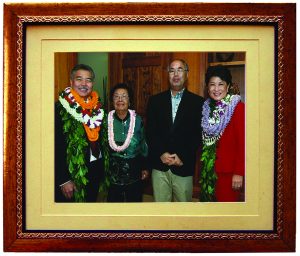
Walk the Walk to End Alzheimer’s Disease
When Dawn and her brother became the primary caregivers for their mother, she reached out to the Alzheimer’s Association in Hawai‘i for information about the disease and tips for caregivers. She also attended the Walk to End Alzheimer’s, where she met many other caregivers and people living with the disease.
“Alzheimer’s is not an easy disease to deal with. You see parts of their personality leave them, or they leave them temporarily, and they forget who different people are in their family. I think that’s really where it hits the heart.”
“When my mother was first diagnosed, I attended a walk because I thought the cause was so important. And to see so many people affected by Alzheimer’s is quite eye-opening,” she says.
The first lady felt such a strong connection to the cause and the people she met at the event that she offered to serve as the statewide honorary chair for the 2020 Walk to End Alzheimer’s on O‘ahu, Maui, Kaua‘i and Hawai‘i Island.
A Product of Her Community
In her role as first lady, Dawn draws on her experience as an educator and businesswoman to support causes she’s passionate about: education, literacy, healthcare and youth.
Dawn is a product of the Ewa Plantation. Like her father, she was actually born in Ewa at the plantation hospital and attended Ewa Elementary, ‘Ilima Intermediate and Campbell High School.
Among the first in her family to graduate from college, Dawn has a bachelor’s degree in journalism and a professional diploma in elementary education from the University of Hawai‘i at Mānoa, and a master’s degree in business from Chaminade University of Honolulu.
And like her mother, Dawn worked for many years in the Hawai‘i Department of Education (HIDOE) as a third grade teacher at Waiau and Waimalu Elementary Schools, and vice principal of Kanoelani Elementary and Moanalua High School. Before that, she served as the marketing director of Kapi‘olani healthcare system and an account executive at the public relations firm of Stryker Weiner Associates. Her resume shows an authentic belief in the causes she continues to support in the community today.
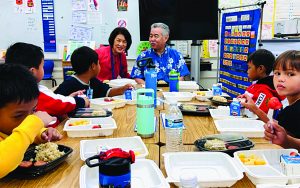 Jump Start Breakfast in Schools
Jump Start Breakfast in Schools
One of the causes Dawn feels most passionate about is feeding Hawai‘i’s children and making sure they start each day with a nutritious breakfast. She recently partnered with Hawai‘i’s public schools and community nonprofit organizations to help kids “Jump Start Breakfast” in schools. And of course, the inspiration for supporting this program comes from her mother, who was once a school cafeteria baker.
“Eating breakfast is important to helping our keiki grow up strong, healthy and academically successful,” Dawn said in an op-ed co-written with HIDOE Superintendent Christina Kishimoto and others.
Hawai‘i ranks last in the nation in school breakfast participation, but kids who eat breakfast have better attendance, can achieve 17.5 percent higher scores in math and are 20 percent more likely to graduate from high school.
Last fall, the program piloted a Grab ’n Go model where kids could pick up free breakfast in the cafeteria and eat it outside or even in the classroom. Dawn is proud that this Grab ’n Go model was used for school meal distribution during the COVID-19 pandemic and may continue to be used in the new school year.
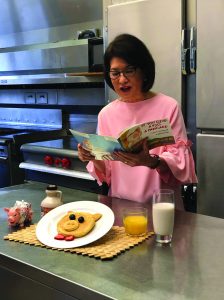
‘Ohana Readers Promoting Literacy
Dawn is also passionate about early education, and is proud of the ‘Ohana Readers literacy program that puts books in the hands of children and encourages families to read together. It’s a partnership with several nonprofit organizations, including the Hawai‘i State Library System, the Friends of the Library of Hawai‘i, Hawai‘i Department of Human Services and Dolly Parton’s Imagination Library.
“Research shows that children are ready to learn in their earliest years,” she points out. “And this program provides no-cost opportunities for learning from birth through age 4. ‘Ohana Readers encourages family read-aloud time, an activity that increases the vocabulary and language skills of our children, and contributes to their growing knowledge of the world.”
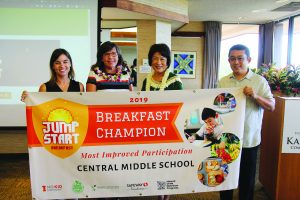 Expansion of the program begun on Moloka‘i and Lāna‘i, is on hold during the ongoing pandemic. But the first lady continues to promote literacy by reading books aloud to children through her Facebook page.
Expansion of the program begun on Moloka‘i and Lāna‘i, is on hold during the ongoing pandemic. But the first lady continues to promote literacy by reading books aloud to children through her Facebook page.
Fading Memories
Mitsue Fukuda was born in 1925 in the small town of Hōnaunau on the Island of Hawai‘i and raised on a small coffee farm in Kealakekua, south of Kona. Memories from her youth have begun to fade away.
After World War II, Mitsue married Sakuji Amano. They lived on O‘ahu, working and raising a family on the Ewa Sugar Plantation. Sakuji was born in Honolulu, raised on the plantation and educated through the seventh grade at Ewa Elementary School.
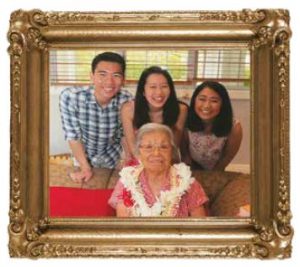
Back at the plantation, Sakuji worked as a crane operator and Mitsue worked nearby as a baker in the Campbell High School cafeteria. Both their jobs were demanding, with long hours. Mitsue’s shift began early in the mornings so she could begin preparing school lunches for hundreds of hungry high school students. In her small plantation community, Mitsue was known as a good cook who enjoyed gardening, and often shared baked goods with friends and family. And together with Sakuji, she raised their children to value hard work and education. Sakuji died in 1989 at the age of 69, leaving his family with fond memories, except for his wartime stories that he never shared.
Mitsue and Sakuji have a son, a daughter and several grandchildren. One grandchild lives in Washington, DC; two live in Washington State; and their daughter lives at Washington Place.
Dawn Amano-Ige and David Ige, Mitsue and Sakuji’s daughter and son-in-law, have lived at the official residence of Hawai‘i’s governors as first lady and governor since 2014. Until 1917, Washington Place had been the private home of Queen Lili‘uokalani, who lived there with her husband. And today, First Lady Dawn Amano-Ige is leading efforts to make the historic executive mansion more accessible to visitors through new technologies and educational experiences such as virtual tours and iPad apps.
Now in the year 2020, it’s clear to see that Mitsue has collected a lifetime of memories — through her own experiences and those of her late husband, their children and grandchildren. But with hindsight that is 20/20, it has also become clear that Mitsue’s memories have faded away and most are completely gone.

Holding On
“I remember going out to my grandfather’s home in Kona when he was alive,” recalls Dawn. “Our relatives would get together there during the summer. My Mom showed me how she picked coffee very much the old-fashioned way — by hand. She could go down a branch of coffee beans and just pick the red ones and leave the green ones behind. It was amazing that she could do it so quickly. It’s a vivid memory for me.”
These are the memories that Dawn holds onto.
“My grandfather came to Hawai‘i to look for a better life and the promise of prosperity,” says Dawn. When Mitsue had a family of her own, she enjoyed telling stories about her small kid times in the small town of Kealakekua.
Dawn has even fewer memories from her father and regrets that she knows little of his WWII experiences. He served with the 100th Infantry Battalion, Company C, which was part of the 442nd Regimental Combat Team, the most decorated unit for its size and length of service in US military history.
“My father spoke little of war and its hardships. David and I speak about this quite often because the strength our fathers carried were so important to our history, and serves as an inspiration to us.”
“We are living through difficult times now. I often think about my parents and how their generation also lived through difficult times — they endured and were never bitter about it. Growing up, they stressed to us the value of working hard, doing well and overcoming challenges without complaining. I admire that about my parents and their parents,” Dawn says.
“I know we’ll be able to get through these difficult times. We have to stay focused, work together as a community and forge ahead. So that’s how I look at their experiences — as an inspiration for me.”
Dawn and her husband haven’t seen Dawn’s mother since mid-March, due to safety precautions in the face of COVID-19.
“We can’t go into the nursing home. And of course, we don’t want to put anyone at risk. We need to keep the residents and the employees safe,” says Dawn.
“An Alzheimer’s patient in a nursing home has to adjust because he or she is missing the physical touch and close proximity of family, which I think are so important. It’s a natural human instinct to want and need those things. And right now, that’s all on hold. We have to look for different ways of communicating. So what can we do instead? We can use technology for virtual visits. Writing letters or having our young ones draw pictures are simple but meaningful ways to connect. Music is also another source of comfort. And I am so appreciative of the caregivers and nurses in my mother’s nursing home, as they are providing the extra care and attention patients need during this time.
Looking Toward a Better Future
“Alzheimer’s and dementia affect so many people we love — and it seems that everyone knows someone affected by Alzheimer’s,” says Dawn. “And we want to do all we can to help them on their journey through this.”
“One way I deal with it is to remember that it’s the disease and not the person, when difficult times occur. And that’s helped me a lot — knowing that it’s a disease where you treat the symptoms like you would in any other disease. And that way, it’s much easier to cope with.”
Admittedly, navigating the healthcare system is daunting, says Dawn. “Many of us take our loved ones through homecare, emergency room, hospital and nursing home. Each of these organizations have decision-making structures that seem mysterious and I’ve simply had to muddle through it all,” she adds. “There are a lot of nice brochures out there. But often, the information must be put in proper context.” Dawn suggests turning to healthcare workers, social workers, care coordinators, support groups, publications like Generations Magazine and organizations like the Alzheimer’s Association for help and resources.
“It’s important to connect; to interact; to know that you’re not alone in this situation,” she adds. “And it’s comforting to know, when you’re met with challenging times, that other people have gone through it — that they have solutions to the same problems. And many have ideas that can make it work. I think those things are important.”
And what’s truly important, Dawn says, is coming together and sharing resources. “Finding the cure is a priority. Together, let’s do all we can to help create a future without this disease and make the place we live a little better.”

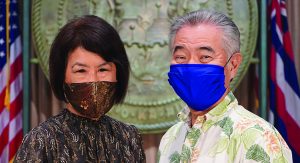

Leave a Reply